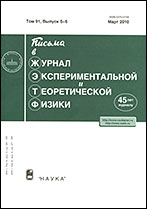|
This article is cited in 5 scientific papers (total in 5 papers)
FIELDS, PARTICLES, AND NUCLEI
Strange quark matter and the astrophysical nature of anomalous effects in 1–100 PeV cosmic rays
S. B. Shaulov, V. A. Ryabov, A. L. Shchepetov, S. E. Pyatovsky, V. V. Zhukov, E. A. Kupriyanova, E. N. Gudkova
Division of Nuclear Physics and Astrophysics, Lebedev Physical Institute, Russian Academy of Sciences,
Moscow, 119991 Russia
Abstract:
The composition of cosmic rays is of decisive importance for the determination of reasons for change in the slope of the spectra of extensive air showers (knee) at energies of 1–100 PeV. The characteristics of the extensive air showers, where the highest energy secondary hadrons are concentrated, have been analyzed. Some anomalous effects such as an increase in the absorption length of hadron showers, scaling violation in the spectra of secondary hadrons, an excess of muons in extensive air showers with gamma-ray families, the appearance of the halos, and the alignment of energy centers along a straight line are observed in X-ray emulsion chambers in the knee region. At the same energies equivalent to 1–100 PeV in the laboratory system, LHC and RHIC data demonstrate a scaling behavior of the hadron spectrum, which means that new nuclear processes are absent. These data imply that anomalies observed in cosmic rays are due to astrophysical reasons, i.e., changes in the composition of cosmic rays. The analysis of the data on the EAS cores suggests that the knee in their spectrum is formed by a nonnuclear component of cosmic rays, possibly consisting of particles of strange quark matter.
Received: 31.03.2022
Revised: 23.05.2022
Accepted: 24.05.2022
Citation:
S. B. Shaulov, V. A. Ryabov, A. L. Shchepetov, S. E. Pyatovsky, V. V. Zhukov, E. A. Kupriyanova, E. N. Gudkova, “Strange quark matter and the astrophysical nature of anomalous effects in 1–100 PeV cosmic rays”, Pis'ma v Zh. Èksper. Teoret. Fiz., 116:1 (2022), 3–12; JETP Letters, 116:1 (2022), 1–10
Linking options:
https://www.mathnet.ru/eng/jetpl6701 https://www.mathnet.ru/eng/jetpl/v116/i1/p3
|


| Statistics & downloads: |
| Abstract page: | 74 | | References: | 22 | | First page: | 11 |
|





 Contact us:
Contact us: Terms of Use
Terms of Use
 Registration to the website
Registration to the website Logotypes
Logotypes







 Citation in format
Citation in format 
